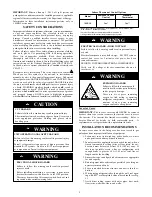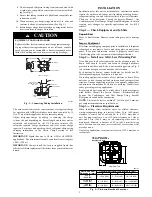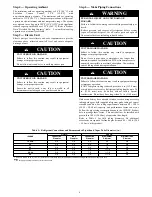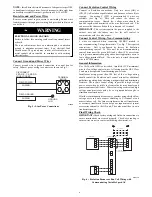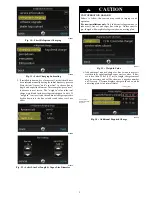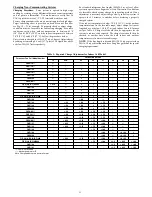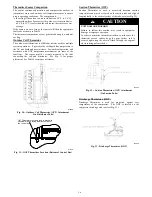
3
8. Do not suspend refrigerant tubing from joists and studs with
a rigid wire or strap which comes in direct contact with tub-
ing (see Fig. 1).
9. Ensure that tubing insulation is pliable and completely sur-
rounds vapor tube.
10. When necessary, use hanger straps which are 1 in. wide and
conform to shape of tubing insulation. (See Fig. 1.)
11. Isolate hanger straps from insulation by using metal sleeves
bent to conform to shape of insulation.
EQUIPMENT DAMAGE HAZARD
Failure to follow this caution may result in equipment damage.
If proper lineset routing techniques are not followed, variable
speed systems can be susceptible to lineset transmitted noise
inside the dwelling and, in extreme cases, tubing breakage.
CAUTION
!
INSULATION
SUCTION TUBE
LIQUID TUBE
OUTDOOR WALL
INDOOR WALL
LIQUID TUBE
SUCTION TUBE
INSULATION
CAULK
HANGER STRAP
(AROUND SUCTION
TUBE ONLY)
JOIST
1” (25.4 mm)
MIN
THROUGH THE WALL
SUSPENSION
A07588
Fig. 1 -- Connecting Tubing Installation
The outdoor unit contains the correct amount of refrigerant charge
for operation with AHRI rated indoor units when connected by 15
ft (4.57 m) of field--supplied or factory accessory tubing.
Adjust refrigerant charge by adding or removing the charge
to/from the unit depending on lineset length and indoor unit as
calculated and displayed on the UI. The user interface (UI)
calculates required charge adjustment and total system charge
required. For proper unit operation, check refrigerant charge using
charging information in the Check Charge section of this
instruction.
IMPORTANT:
Liquid--line size is 3/8--in. OD for all 189BNV
applications. The maximum allowable equivalent line set length is
100 ft. (30.5 m).
IMPORTANT:
Always install the factory--supplied liquid--line
filter drier. Obtain replacement filter driers from your distributor or
branch.
INSTALLATION
Specifications for this unit in residential new construction market
require the outdoor unit, indoor unit (including metering device),
refrigerant tubing sets, and filter drier listed in pre--sale literature.
There can be no deviation. Consult the Service Manual – Air
Conditioners and Heat Pumps Using Puron
Refrigerant to obtain
required unit changes for specific applications and for R--22
retrofit.
Step 1 — Check Equipment and Job Site
Unpack Unit
Move to final location. Remove carton taking care not to damage
unit.
Inspect Equipment
File claim with shipping company prior to installation if shipment
is damaged or incomplete. Locate unit rating plate on unit corner
panel. It contains information needed to properly install unit.
Check rating plate to be sure unit matches job specifications.
Step 2 — Install on a Solid, Level Mounting Pad
If conditions or local codes require the unit be attached to pad, tie
down bolts should be used and fastened through knockouts
provided in unit base pan. Refer to unit mounting pattern in Fig. 2
to determine base pan size and knockout hole location.
For hurricane tie downs, contact distributor for details and PE
(Professional Engineer) Certification, if required.
On rooftop applications, mount on level platform or frame. Place
unit above a load--bearing wall and isolate unit and tubing set from
structure. Arrange supporting members to adequately support unit
and minimize transmission of vibration to building. Consult local
codes governing rooftop applications.
Roof mounted units exposed to winds above 5 mph may require
wind baffles. Consult the Service Manual -- Residential Split
System Air Conditioners and Heat Pumps Using Puron
Refrigerant for wind baffle construction.
NOTE:
Unit must be level to within
2
(
3/8 in./ft,
9.5 mm/m.)
per compressor manufacturer specifications.
Step 3 — Clearance Requirements
When installing, allow sufficient space for airflow clearance,
wiring, refrigerant piping, and service. Allow 24 in. (609.6 mm)
clearance to service end of unit and 48 in. (1219.2 mm) (above
unit. For proper airflow, a 6--in. (152.4 mm) clearance on 1 side of
unit and 12--in. (304.8 mm) on all remaining sides must be
maintained. Maintain a distance of 24 in. (609.6 mm) between
units. Position so water, snow, or ice from roof or eaves cannot fall
directly on unit.
On rooftop applications, locate unit at least 6 in. (152.4 mm) above
roof surface.
3/8---in. (9.53 mm) Dia.
Tie---down Knockouts in
Basepan(2) Places
View From Top
A05177
UNIT BASE PAN
Dimension in. (mm)
TIEDOWN KNOCKOUT LOCATIONS in. (mm)
A
B
C
23 X 23
(596 X 596)
7---13/16 (198)
4---7/16 (102)
18---1/8 (458)
31.2 X 31.2
(792 X 792)
9---1/8 (232)
6---9/16 (167)
24---11/16 (627)
35 X 35
(889 X 889)
9---1/8 (232)
6---9/16 (167)
28---7/16 (722)
Fig. 2 -- Tie--down Knockout Locations


